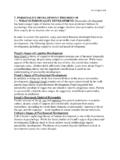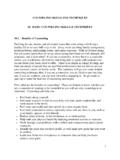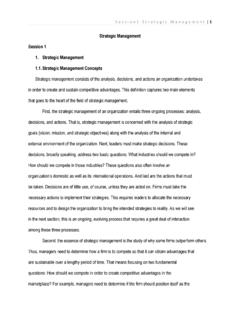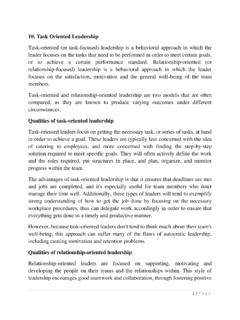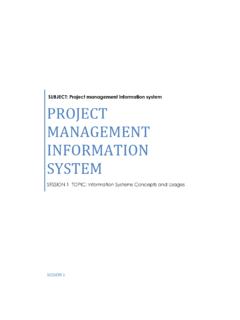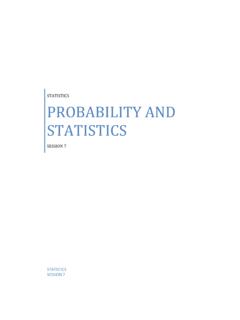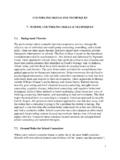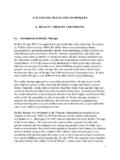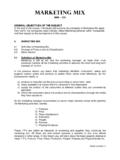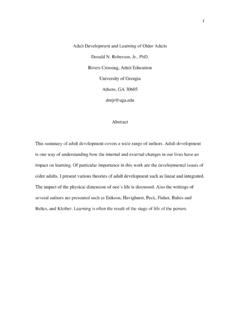Transcription of COUNSELING SKILLS AND TECHNIQUES 3. PSYCHOANALYTIC ...
1 1 COUNSELING SKILLS AND TECHNIQUES 3. PSYCHOANALYTIC COUNSELING What is PSYCHOANALYTIC COUNSELING ? Psychoanalysis is a set of psychological and psychotherapeutic theories and associated TECHNIQUES , originally popularized by Austrian physician Sigmund freud and stemming partly from the clinical work of Josef Breuer and others. Since then, psychoanalysis has expanded and been revised, reformed and developed in different directions. This was initially by freud 's colleagues and students, such as Alfred Adler and Carl Gustav Jung who went on to develop their own ideas independently from freud . Later neo-Freudians included Erich Fromm, Karen Horney, Harry Stack Sullivan and Jacques Lacan. The basic tenets of psychoanalysis include the following: 1.
2 Besides the inherited constitution of personality, a person's development is determined by events in early childhood; 2. Human attitude, mannerism, experience, and thought is largely influenced by irrational drives; 3. Irrational drives are unconscious; 4. Attempts to bring these drives into awareness meet psychological resistance in the form of defense mechanisms; 5. Conflicts between conscious and unconscious, or repressed, material can materialize in the form of mental or emotional disturbances, for example: neurosis, neurotic traits, anxiety, depression etc.; 6. The liberation from the effects of the unconscious material is achieved through bringing this material into the conscious mind (via skilled guidance, therapeutic intervention).
3 Under the broad umbrella of psychoanalysis there are at least 22 theoretical orientations regarding human mental development. The various approaches in treatment called psychoanalysis vary as much as the theories do. The term also refers to a method of analyzing child development. Freudian psychoanalysis refers to a specific type of treatment in which the "analysand" (analytic patient) verbally expresses his thoughts, including free associations, fantasies, and dreams, from which the analyst induces the unconscious conflicts causing the patient's symptoms and character problems, and interprets them for the patient to create insight for 2 resolution of the problems. The analyst confronts and clarifies the patient's pathological defenses, wishes and guilt.
4 Through the analysis of conflicts, including those contributing to resistance and those involving transference onto the analyst of distorted reactions, PSYCHOANALYTIC treatment can hypothesize how patients unconsciously are their own worst enemies, in other words how unconscious, symbolic reactions that have been stimulated by experience are causing symptoms. Psychoanalysis has received criticism from a wide variety of sources. One notable critique of psychoanalysis is that it constitutes a pseudoscience. Nonetheless, it remains a strong influence within the realm of psychiatry, and more so in some quarters than others. Treatment Using the various analytic and psychological TECHNIQUES to assess mental problems, some believe that there are particular constellations of problems that are especially suited for analytic treatment whereas other problems might respond better to medicines and other interpersonal interventions.
5 To be treated with psychoanalysis, whatever the presenting problem, the person requesting help must demonstrate a desire to start an analysis. The person wishing to start an analysis must have some capacity for speech and communication. As well, they need to be able to have or develop trust and insight within the PSYCHOANALYTIC session. Potential patients must undergo a preliminary stage of treatment to assess their amenability to psychoanalysis at that time, and also to enable the analyst to form a working psychological model, which the analyst will use to direct the treatment. Psychoanalysts mainly work with neurosis and hysteria in particular; however, adapted forms of psychoanalysis are used in working with schizophrenia and other forms of psychosis or mental disorders.
6 Finally, if a prospective patient is severely suicidal a longer preliminary stage may be employed, sometimes with sessions which have a twenty minute break in the middle. There are numerous modifications in technique under the heading of psychoanalysis due to the individualistic nature of personality in both analyst and patient. The most common problems treatable with psychoanalysis include: phobias, conversions, compulsions, obsessions, anxiety, attacks, depressions, sexual dysfunctions, a wide variety of relationship problems (such as dating and marital strife), and a wide variety of character problems (for example, painful shyness, meanness, obnoxiousness, workaholism, hyperseductiveness, hyperemotionality, 3 hyperfastidiousness).
7 The fact that many of such patients also demonstrate deficits above makes diagnosis and treatment selection difficult. Analytical organizations such as the IPA, APsaA and the European Federation for PSYCHOANALYTIC Psychotherapy have established procedures and models for the indication and practice of psychoanalytical therapy for trainees in analysis. The match between the analyst and the patient can be viewed as another contributing factor for the indication and contraindication for PSYCHOANALYTIC treatment. The analyst decides whether the patient is suitable for psychoanalysis. This decision made by the analyst, besides made on the usual indications and pathology, is also based to a certain degree by the "fit" between analyst and patient.
8 A person's suitability for analysis at any particular time is based on their desire to know something about where their illness has come from. Someone who is not suitable for analysis expresses no desire to know more about the root causes of their evaluation may include one or more other analysts' independent opinions and will include discussion of the patient's financial situation and insurances. TECHNIQUES The basic method of psychoanalysis is interpretation of the patient's unconscious conflicts that are interfering with current-day functioning with conflicts that are causing painful symptoms such as phobias, anxiety, depression, and compulsions. Early researchers stressed that figuring out ways the patient distorted perceptions about the analyst led to understanding what may have been forgotten.
9 In particular, unconscious hostile feelings toward the analyst could be found in symbolic, negative reactions to what has been called the "frame" of the therapy the setup that included times of the sessions, payment of fees, and necessity of talking. In patients who made mistakes, forgot, or showed other peculiarities regarding time, fees, and talking, the analyst can usually find various unconscious resistances to the flow of thoughts (sometimes called free association). When the patient reclines on a couch with the analyst out of view, the patient tends to remember more, experiences more resistance and transference, and is able to reorganize thoughts after the development of insight through the interpretive work of the analyst.
10 Typically, fantasy life can be understood through the examination of dreams. The analyst is interested in how the patient reacts to and avoids such fantasies. Additionally, various memories of early life are generally distorted. freud called them "screen memories" and in any case, very early experiences (before age two) cannot be remembered. 4 Variations In Technique There is what is known among psychoanalysts as "classical technique," although freud throughout his writings deviated from this considerably, depending on the problems of any given patient. Classical technique was summarized by Allan Compton, MD, as comprising instructions which includes telling the patient to try to say what's on their mind, including interferences; exploration including asking questions; and clarification inclusive of rephrasing and summarizing what the patient has been describing.
